Breast Augmentation Mammaplasty

Before and after photo of a breast augmentation (front view).
Breast augmentation surgery, or augmentation mammaplasty, is a surgical procedure that enlarges and enhances a woman’s breasts. Typically, this is performed using breast implants. Fat grafting, or fat transfer breast augmentation can also enlarge or enhance a woman’s breasts. However, only small changes in breast size can be achieved with this fat grafting technique, and the patient needs to have a sufficient amount of fatty tissue to be liposuctioned from other areas of her body to be used for fat grafting.
Breast augmentation surgery is one of the most common cosmetic surgical procedures performed. There are a variety of predisposing factors as to why a woman desires this procedure. These include having naturally small breasts, having asymmetric breasts or developing deflated breasts after having children, breastfeeding or with weight changes. In addition, women with ample sized breasts may also desire to enhance the size and the shape of their breasts.
Incision Sites
Incision sites for breast augmentation are made in inconspicuous areas to minimize visible scarring. These sites include: in the breast crease (infra mammary fold) which is the most common location, around the lower half of the areola (peri-areola), and in the arm pit (transaxillary).
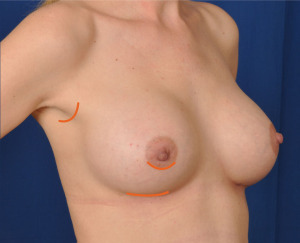
Incision sites for breast augmentation are demonstrated.
Implant Placement
For the past twenty plus years, the most common implant placement site has been subpectoral, that is, underneath the pectoralis muscle. The subpectoral approach is performed, using the Dual Plane technique with two-thirds of the implant placed under the muscle medially and one-third of the implant placed over the muscle laterally. The implants are placed behind the muscle in order to reduce the risk of scar tissue capsular contracture, visibility and palpability of the implants. Over twenty years ago, implants were more typically placed under the breast tissue, or subglandular/submammary, that is, above the pectoralis muscle.

Left image shows a breast implant under the chest muscle. Right image shows a breast implant above the chest muscle.
Silicone or Saline
Smooth round cohesive silicone gel breast implant. Gel implants are pre-filled and sealed at the base of the implant.
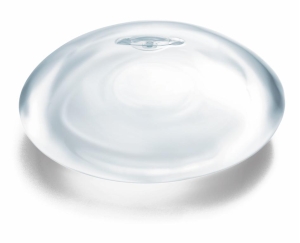
Smooth round saline breast implant. Note the fill valve at top of implant. At the time of surgery, saline implants are filled with saline (salt water) using tubing connected to the fill valve.
How do Mentor Cohesive MemoryGel® Breast Implants compare to MENTOR® Saline Filled Breast Implants?
MemoryGel® Breast Implants
- MemoryGel® Breast Implants are FDA approved
- Each implant is filled with Mentor’s proprietary cohesive gel
- The gel filler holds together uniformly and retains a natural give that resembles breast tissue
- The implants have a set fill volume for predictable results
- MemoryGel® Breast Implants come in four projection options: Moderate Classic, Moderate Plus, High, and Ultra High Profile to give you just the look you want
- They come in two shell surface options: smooth and textured
- Mentor’s MemoryGel® Breast Implants are covered by the Mentor Premier Advantage Warranty
MENTOR® Saline Filled Breast Implants
- Saline Breast Implants are FDA approved
- These implants are filled with a saltwater solution similar to the fluid that makes up most of the human body
- Saline implants have a slightly firmer feel than gel-filled implants
- They have a flexible fill volume that can be adjusted during the procedure
- They come in two shell surface options: smooth and textured
- You can choose from three projection options: Moderate, Moderate Plus and High Profile
- Mentor’s saline implants are covered by the Mentor Standard or Enhanced Limited Warranty and Lifetime Replacement Policy
Silicone breast implants are filled with silicone gel. The gel feels more like natural breast tissue. If there is a tear in the outer shell of the implant, the cohesive silicone gel sticks together, unlike the older type silicone gel implants which create a gooey mess when ruptured.
Round or Shaped
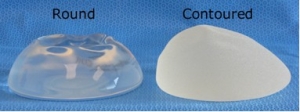
The majority of breast augmentations are performed with smooth round cohesive silicone gel implants, and this is Dr. Franco-Webb’s preference as well. Round cohesive silicone gel implants were designed such that more gel flows to the bottom creating an anatomical shape when you are upright. Dr. Franco-Webb will demonstrate this to you during your consultation. Shaped implants, which are always textured, can potentially rotate. Even five degrees of rotation can cause rotational deformities that produce an oddly shaped breast. The so-called “Gummy Bear Implants” can potentially have this problem. During her many years reconstructing patients, Dr. Franco-Webb used shaped implants for breast cancer patients. The shaped implant is ideal for those reconstructive cases.
Smooth or Textured
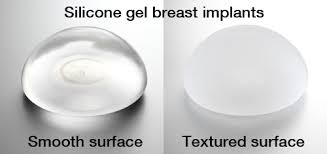
As noted above, the majority of breast augmentations are performed with smooth round cohesive silicone gel implants, and this is Dr. Franco-Webb’s preference as well. All shaped implants are textured. Textured implants were thought to have less incidence of capsular contractures, but that is debatable. Textured implants may tend to have a slightly higher incidence of rupture.
Implant Profiles
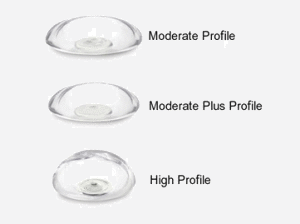
There are different profiles of breast implants to choose from: Moderate Classic, Moderate Plus, High and Ultra High.
When comparing these profiles using the same fill volume, they are, from top to bottom, wider in diameter with less projection (Moderate Profile) to narrower in diameter with the more projection (High Profile). There is now an Ultra High Profile gel implant available for the most projection.
The type of profile is chosen based on multiple factors: What type of upper slope you desire, how much volume you want to add, and what your chest measurements are.
After listening to your expectations and after examining you, Dr. Franco-Webb will make her recommendations regarding the implant profile.
Breast Implant Safety
Note: Breast implants do not impair breast health.
Careful reviews of scientific research by independent groups such as the Institute of Medicine have found no link between breast implants and autoimmune or other systemic diseases.
Other important considerations:
- Breast implants are not guaranteed to last a lifetime and future surgery may be required to replace one or both implants
- Pregnancy, weight loss, and menopause may influence the appearance of augmented breasts over the course of your lifetime
- Breast augmentation requires regular examinations of your breasts’ health and to evaluate the condition of your breast implants
It has been shown that women with breast implants have no higher incidence of fibromyalgia, systemic lupus, autoimmune disease or increased risk of breast cancer than those women who have had no breast implants.
The Consultation
During your complimentary consultation with Dr. Franco-Webb, she will review your medical and surgical history. She will discuss your overall goals with you. She will describe for you the surgical procedure and the recovery phase, answering all of your questions. She will then examine and measure you, noting any asymmetries, skin quality and position of your nipples. Then, while wearing a surgical bra in the cup size you desire, you will try on Mentor Volume Sizers to assist you in determining what size you would like to be and what compliments your body type.
After your consultation with Dr. Franco-Webb, you will receive a price quote for the procedure, as well as receive further information about the process of scheduling surgery.
Cost
The cost of a breast augmentation surgery with silicone cohesive gel implants is $7,000.00. For saline breast implants, the cost is $6,700.00. This includes the surgeon’s fee, anesthesia fee, surgical facility fee, implant cost, bras, labs and all clinic visits.
The Pre-Surgical Appointment
Approximately two weeks prior to your surgery, you will meet with Dr. Franco-Webb and her staff again. You will receive your prescriptions and thorough instructions for before and after surgery. Your pre surgical photos will be taken. You will review the surgical procedure and your desired outcome with Dr. Franco-Webb. You will again try on the Mentor Volume Sizers and confirm what size implants you desire. All of your questions will be answered.
InSight Surgery Center
Dr. Franco-Webb performs all of her surgical procedures at InSight (formerly Renewal) Surgery Center. InSight is an outpatient surgery center, fully accredited by the Association of Ambulatory Care Facilities. It is located in Lone Tree, Colorado. InSight’s nursing staff will contact you days prior to your procedure to review your medical history, give you instructions for before your surgery, and to answer your questions.
On the day of your surgery, you will arrive at the surgery center 1-1/2 hours prior to your surgery time, having refrained from eating or drinking since midnight. One of our nurses will check you in and place an IV for medications. You will meet with one of our Board Certified Anesthesiologist Physicians who will review your medical history, explain the anesthesia process and answer your questions. Dr. Franco-Webb will review with you the plans for your procedure. She will mark your incision lines for surgery.
The Procedure
You will be taken back to the operating room and placed on an operating bed. Your anesthesiologist will proceed with general anesthesia. Your arms will be placed on arm boards, wrapped and secured and symmetrically positioned. This is done because, at multiple points during your procedure, you will be sat upright to check for size, shape, position and symmetry of your breasts. Your chest will be prepped and draped sterilely.
An incision, approximately 1-1/2 inch long (depending on the size of your implants) will be made in your breast crease (or adjusted breast crease). The breast tissue and then the lateral edge of the pectoralis muscle is lifted. Dr. Franco-Webb carefully creates a “pocket”underneath this muscle, stretching this muscle to create space for the desired cleavage and breast fullness. A resterilizable breast sizer of the patient’s desired breast volume is placed into the breast pocket.
This same procedure is performed on the opposite breast. You are then sat upright and your breasts are evaluated for size, shape, position and symmetry. If necessary, adjustments in the sizers and/or pocket space will be made to achieve the best possible outcome. The sizers are then removed and the pockets are irrigated and any bleeding is stopped with a cautery. The permanent implants are then placed and the incisions are then closed with three layers of dissolvable sutures and covered with sterile dressings. You are placed in a surgical bra, awoken from general anesthesia and extubated, and taken to our recovery room.
The Recovery Room
In the recovery room, two of our well skilled nurses will monitor you. They will make sure that you are recovering comfortably from surgery. Our patients are typically in the recovery room for one hour. During that time, your nurse will review with your caregiver the instructions that Dr. Franco-Webb had reviewed with you during your pre surgery appointment.
Recovery Period
The First Few Days
- You will probably feel fatigued and sore for several days after the breast augmentation surgery, so rest is essential as well as staying well hydrated.
- Follow Dr. Franco-Webb’s instructions, including taking your prescription medication as directed and icing your breasts.
- It’s normal to experience a feeling of tightness in the breast area as your skin adjusts to your new breast size and your breast implants. You may also notice diminished feeling in your breasts and nipples during immediate recovery.
- You will be wearing a postoperative bra while you heal.
- Most patients are able to return to work within a few days after their procedure.
First Post Surgery Visit (1 day after surgery):
During this visit, Dr. Franco-Webb will check to see that your breasts are healing well. She will review your medications and your activity level. It’s best to avoid any strenuous activities that could raise your pulse and blood pressure, or which require strenuous use of your arms and chest. You will be able to shower two days after your surgery.
Second Post Surgery Visit (8 days after surgery):
During this visit, Dr. Franco-Webb will check to see that your breasts are healing well. She will review your medications and your activity level. It’s best to avoid any strenuous activities that could raise your pulse and blood pressure, or which require strenuous use of your arms and chest. She will show you how to perform gentle breast massage.
Three to Four Weeks Post Surgery Visit
During this visit, Dr. Franco-Webb will check to see that your breast incisions have healed. She will advise you regarding scar treatments to provide you with the most optimal end result. At this point, you should be off medications. She will review your activity level. After 4 weeks from surgery, you can discontinue wearing your surgical bra during the day and choose to wear whatever is comfortable for you. You should, however, continue to wear your surgical bra at night for an additional 4 weeks.
Two to Three Months Post Surgery Visit
During this visit, Dr. Franco-Webb will check to see that your breast incisions are fading well. Post surgery photographs will be taken and you will be provided with before and after photos.
Six to Twelve Months Post Surgery Visits
During this visit, Dr. Franco-Webb will check to see that your breast incisions are fading well. It takes approximately one to two years before a scar is fully matured. Post surgery photographs will be taken and you will be provided with before and after photos.
You are always welcome to return to our clinic as all visits are included in the cost. At any time, you may contact our Staff or contact Dr. Franco-Webb directly as all of her patients are provided with her cell phone number.
Return to Exercise
One week after surgery, you can walk outside. Three weeks after surgery, you can walk on a treadmill, ride a stationary bike or work out on an elliptical machine without using your arms. Six to eight weeks after surgery, you can engage in more physical activity such as jogging. However, you will need to wear a “high impact” zip front sports bra. Dr. Franco-Webb will thoroughly discuss your return to exercise timeline with you. Once you have completely healed from your surgery, she would like to encourage an active and energetic lifestyle for you!
